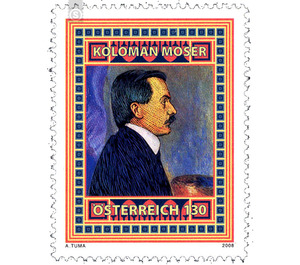Artist - Austria / II. Republic of Austria 2008 - 130 Euro Cent
Theme: Well-known people
| Country | Austria / II. Republic of Austria |
| Issue Date | 2008 |
| Face Value | 130.00 |
| Edition Issued | 1,200,000 |
| Printing Type | offset |
| Stamp Type | Commemorative |
| Item Type | Stamp |
| Chronological Issue Number | 2117 |
| Chronological Chapter | OOS-OE2 |
| SID | 490927 |
| In 59 Wishlists | |
Together with Josef Hoffmann, Egon Schiele, Gustav Klimt and Adolf Loos, Koloman Moser (1868-1918) is one of the internationally important artists who at the turn of the century introduced the great era of Austrian Modernism. What she combined was her creative engagement, which was not exhausted in imitating historical styles. Kolo Moser's endeavors, however, were devoted to a new Gesamtkunstwerk, in which everything from architecture to the smallest decoration element on a commodity of everyday life should be created in a strict art form. "Seeing has not changed, but the representation of the seen. Just as the human sensations were always the same and only changed in their form of representation, were refined and differentiated. "This sentence became the maxim of his artistic work to a certain extent - as well as the succinct formulation:" Simplification is not in omission, but in summarizing. "Kolo Moser's ideas of creatively designed design were undoubtedly in the direction of Austrian turn-of-the-century art. Not only his numerous contributions to the world-famous magazine "Ver Sacrum" and his designs for the glass windows and the high altar of the church built by Otto Wagner Am Steinhof show his secessionist attitude - Moser's design of furniture, carpets, crockery and fabrics set the standard for the modern lifestyle par excellence. Only later did Moser turn to painting, dealt with Goethe's theory of color and tried to develop it further and apply it in his work. However, Koloman Moser achieved great fame with his designs for flat art - for posters, postcards, banknotes and stamps. A milestone in European philately was the first use of landscape motifs as visual representation on Postwertzeichen. Until then, the usual coats of arms and ruler portraits, often in medallion form, were found on stamps; Moser founded the international reputation of Austrian brand art in 1906 with the series "Bosnia-Herzegovina". He achieved the required connection between pictorial representation and the indispensable written elements with a ornamentalization and later varied imaginative motifs, which responded to the respective character of the enclosed image in a highly subtle way. This type of brand determined - not only in Austria - the later design of postage stamps.


